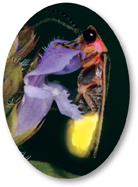Communication
 How do animals communicate with others in their environments?
How do animals communicate with others in their environments?
Because social behavior involves more than one individual, it requires communication—the passing of information from one organism to another.  Animals may use a variety of signals to communicate with one another. Some animals are also capable of language. The specific techniques that animals use depend on the types of stimuli their senses can detect.
Animals may use a variety of signals to communicate with one another. Some animals are also capable of language. The specific techniques that animals use depend on the types of stimuli their senses can detect.
Visual Signals Many animals have eyes that sense shapes and colors at least as well as humans do, and they often use visual signals. For example, squids, which have large eyes, change their color to broadcast a variety of signals. In many animal species, males and females have different color patterns, and males use color displays to advertise their readiness to mate. Some animals, such as fireflies, even send signals using light generated within their bodies, as you can see in Figure 29–10.
Chemical Signals Animals with well-developed senses of smell, including insects, fishes, and many mammals, can communicate with chemicals. For example, some animals, including lampreys, bees, and ants, release pheromones (FEHR uh mohnz), chemical messengers that affect the behavior of other individuals of the same species, to mark a territory or to signal their readiness to mate.

FIGURE 29–10 Types of Communication Different animals rely on different methods of communication to get their messages across. Fireflies, for example, flash a light generated within their bodies to attract mates.
Analyzing Data
Caring for Young
Can experience help animals other than humans learn to care for their young better? The data at the right are from field studies of a seabird, the short-tailed shearwater. Each pair produces only one egg a year. If that egg breaks or if the chick dies, the egg is not replaced. The graph shows the percentage of eggs that develop into free-flying young, in relation to the breeding experience of the parents. This ratio is called reproductive success.
Interpret Tables What is the approximate success rate of a female shearwater with five years of breeding experience?
Compare and Contrast Are there obvious differences in reproductive success between male and female shearwaters?
Draw Conclusions Do older shearwaters have better reproductive success than younger birds have? Explain your answer.
Form a Hypothesis Do you think these birds learn to raise young more successfully over time? Is there an alternative hypothesis that could explain these data?
Table of Contents
- Formulas and Equations
- Applying Formulas and Equations
- Mean, Median, and Mode
- Estimation
- Using Measurements in Calculations
- Effects of Measurement Errors
- Accuracy
- Precision
- Comparing Accuracy and Precision
- Significant Figures
- Calculating With Significant Figures
- Scientific Notation
- Calculating With Scientific Notation
- Dimensional Analysis
- Applying Dimensional Analysis





